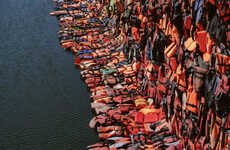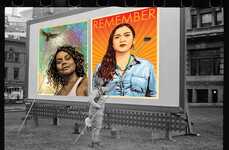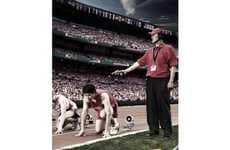
Making the Invisible Visible Highlights Human Rights Abuses
Kirsten Rutherford — December 3, 2011 — Pop Culture
References: mentalgassi.blogspot & making-the-invisible-visible.posterous
With their powerful fence railing street art, Amnesty International have teamed up once again with Mentalgassi to campaign for the 2011 'Making the Invisible Visible' campaign. Following the widespread awareness raised for Troy Davis with London installations last year, this year's work highlights six cases in 26 sites across Europe.
The fence art is invisible front on, with the face of an individual only appearing to those who approach the railings from side the side. A plaque on the fence directs passersby to a website where they can take action and learn more about the specific case.
The fence art is part of Amnesty's Write for Rights campaign, which encourages hundreds of thousands of people to take action and write letters of support for those around the world who have suffered human rights abuse.
Those who appear on the fences include Fatima Hussein Badi, who faces the death penalty in Yemen after an unfair trial. Jabbar Savalan, a student in Azerbaijan, is serving a two and a half year prison sentence for his peaceful anti-government activism. Jean-Claude Roger Mbede is serving a three-year prison sentence in Cameroon for homosexuality and attempted homosexuality and faces continued risk of homophobic attacks. Halil Savda faces continued risk of imprisonment in Turkey for freely expressing support for conscientious objectors. Filep Karma is currently serving a 15-year sentence in Indonesia for taking part in a ceremony where a Papuan independence flag was raised, and Natalia Estemirova, a Russian human rights activist was abducted and killed in Chechnya in 2009. Her death still hasn't been brought to justice.
Find out more about Making the Invisible Visible at http://making-the-invisible-visible.posterous.com and take action at amnesty.org/arts
The fence art is invisible front on, with the face of an individual only appearing to those who approach the railings from side the side. A plaque on the fence directs passersby to a website where they can take action and learn more about the specific case.
The fence art is part of Amnesty's Write for Rights campaign, which encourages hundreds of thousands of people to take action and write letters of support for those around the world who have suffered human rights abuse.
Those who appear on the fences include Fatima Hussein Badi, who faces the death penalty in Yemen after an unfair trial. Jabbar Savalan, a student in Azerbaijan, is serving a two and a half year prison sentence for his peaceful anti-government activism. Jean-Claude Roger Mbede is serving a three-year prison sentence in Cameroon for homosexuality and attempted homosexuality and faces continued risk of homophobic attacks. Halil Savda faces continued risk of imprisonment in Turkey for freely expressing support for conscientious objectors. Filep Karma is currently serving a 15-year sentence in Indonesia for taking part in a ceremony where a Papuan independence flag was raised, and Natalia Estemirova, a Russian human rights activist was abducted and killed in Chechnya in 2009. Her death still hasn't been brought to justice.
Find out more about Making the Invisible Visible at http://making-the-invisible-visible.posterous.com and take action at amnesty.org/arts
Trend Themes
1. Interactive Street Art - The use of invisible front on art that only reveals itself from certain angles creates a unique and engaging interactive experience.
2. Human Rights Activism - Using art installations to raise awareness of human rights abuses and encourage action brings attention to important global issues.
3. Digital Engagement - The inclusion of a website where viewers can take action and learn more about specific cases demonstrates the power of digital platforms in driving social change.
Industry Implications
1. Art and Design - Artists and designers can explore innovative ways to use interactive installations to address social and political issues.
2. Nonprofit and Activism - Nonprofit organizations and activists can leverage street art to raise awareness and mobilize support for their causes.
3. Digital Platforms - Companies and organizations can develop digital platforms that facilitate engagement and action, connecting people to important causes.
5.3
Score
Popularity
Activity
Freshness















